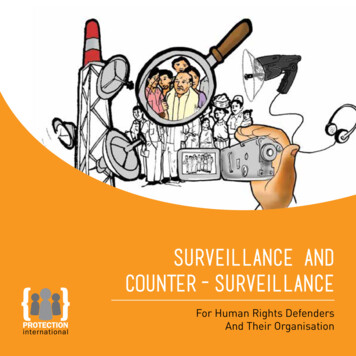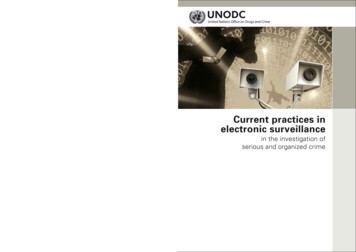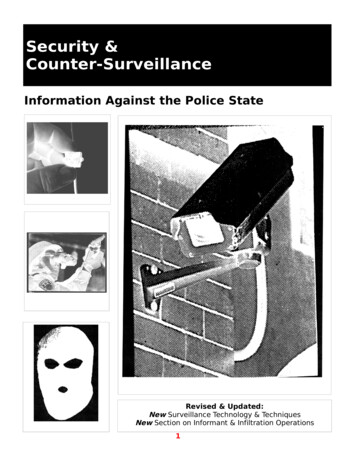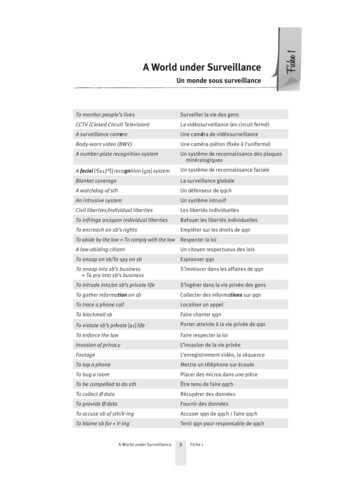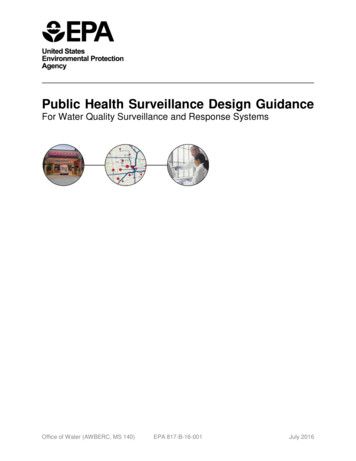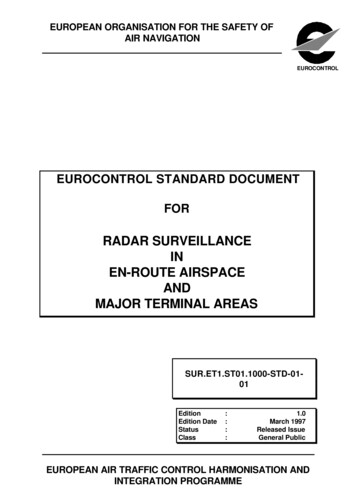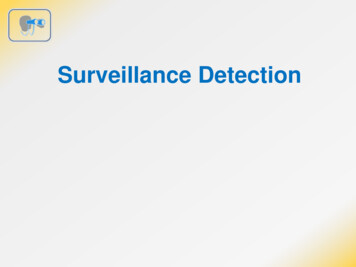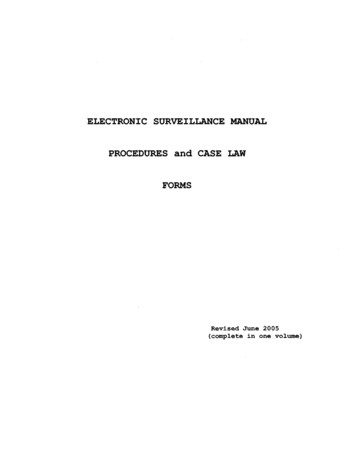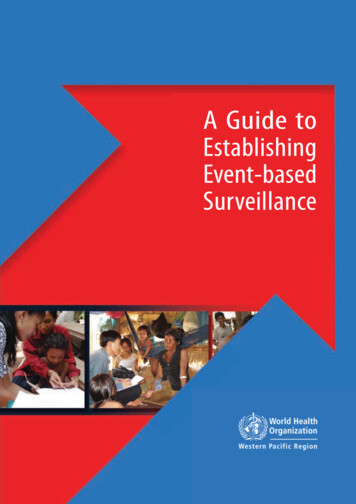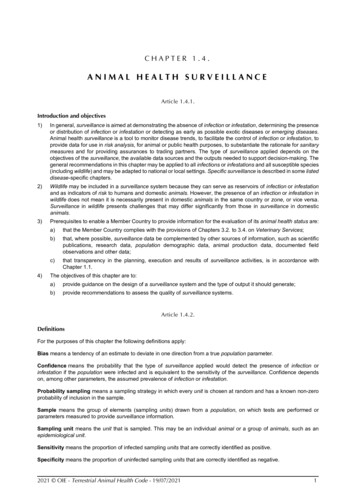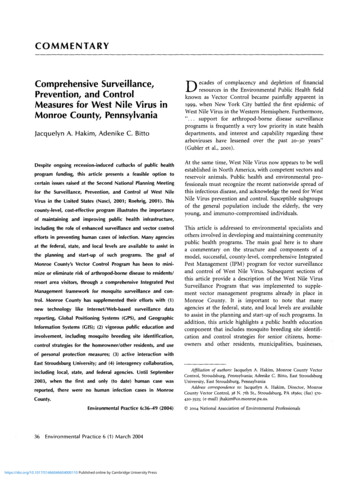
Transcription
COMMENTARYComprehensive SurveiI lance,Prevention, and ControlMeasures for West Nile Virus inMonroe County, PennsylvaniaJacquelyn A. Hakim, A d e n i k e C. BittoDespite ongoing recession-induced cutbacks of public healthprogram funding, this article presents a feasible option tocertain issues raised at the Second National Planning Meetingfor the Surveillance, Prevention, and Control of West NileVirus in the United States (Nasci, 2001; Roehrig, 2001). Thiscounty-level, cost-effective program illustrates the importanceDecades of complacency and depletion of financialresources in the Environmental Public Health fieldknown as Vector Control became painfully apparent in1999, when New York City battled the first epidemic ofWest Nile Virus in the Western Hemisphere. Furthermore,. . support for arthropod-borne disease surveillanceprograms is frequently a very low priority in state healthdepartments, and interest and capability regarding thesearboviruses have lessened over the past 20-30 years”(Gubler et al., 2001).‘I.At the same time, West Nile Virus now appears to be wellestablished in North America, with competent vectors andreservoir animals. Public health and environmental professionals must recognize the recent nationwide spread ofthis infectious disease, and acknowledge the need for WestNile Virus prevention and control. Susceptible subgroupsof the general population include the elderly, the veryyoung, and immuno-compromised individuals.of maintaining and improving public health infrastructure,including the role of enhanced surveillance and vector controlefforts in preventing human cases of infection. Many agenciesat the federal, state, and local levels are available to assist inthe planning and start-up of such programs. The goal ofMonroe County’s Vector Control Program has been to minimize or eliminate risk of arthropod-borne disease to residents/resort area visitors, through a comprehensive Integrated PestManagement framework for mosquito surveillance and control. Monroe County has supplemented their efforts with (1)new technology like Internet/Web-based surveillance datareporting, Global Positioning Systems (GPS), and Geographicinformation Systems (CIS); (2) vigorous public education andinvolvement, including mosquito breeding site identification,control strategies for the homeowner/other residents, and useThis article is addressed to environmental specialists andothers involved in developing and maintaining communitypublic health programs. The main goal here is to sharea commentary on the structure and components of amodel, successful, county-level, comprehensive IntegratedPest Management (IPM) program for vector surveillanceand control of West Nile Virus. Subsequent sections ofthis article provide a description of the West Nile VirusSurveillance Program that was implemented to supplement vector management programs already in place inMonroe County. It is important to note that manyagencies at the federal, state, and local levels are availableto assist in the planning and start-up of such programs. Inaddition, this article highlights a public health educationcomponent that includes mosquito breeding site identification and control strategies for senior citizens, homeowners and other residents, municipalities, businesses,of personal protection measures; (3) active interaction withEast Stroudsburg University; and (4) interagency collaboration,including local, state, and federal agencies. Until September2003, when the first and only (to date) human case wasreported, there were no human infection cases in MonroeCounty.Environmental Practice 636-49 (2004)36Environmental Practice 6 (1) March 2004https://doi.org/10.1017/S1466046604000110 Published online by Cambridge University PressAfliliation of authors: Jacquelyn A. Hakirn, Monroe County VectorControl, Stroudsburg, Pennsylvania; Adenike C. Bitto, East StroudsburgUniversity, East Stroudsburg, PennsylvaniaAddress correspondence to: Jacquelyn A. Hakirn, Director, MonroeCounty Vector Control, 38 N. 7th St., Stroudsburg, PA 18360; (fax) 570420-3525; (e-mail) jhakim@co.rnonroe.pa.us.0 2004 National Association of Environmental Professionals
wastewater treatment plant operators, recreational facilities, health agencies, and local news media outlets.BackgroundWest Nile Virus is a neurotropic virus of the complexknown as flaviviruses (genus Flavivirus, family Flaviviridae), and was first isolated in 1937 from the blood ofa Ugandan woman in a sleeping sickness survey, followinga febrile illness (Smithburn et al., 1940). Since then, it hasbeen isolated from birds, mosquitoes, and mammals(Hurlbut, 1956). West Nile Virus causes sporadic outbreaksof disease throughout parts of the Old World, includingAfrica, Europe, the Middle East, and as far to the east asThailand (Hubalek and Halouzka, 1999).Until recently, the outbreaks in the Eastern Hemispherewere small and infrequent, averaging about every 10 years.In 1996, the pattern was broken when Bucharest reportednearly 400 human cases, with a case fatality rate of 10%(Malkinson et al., 2002). Since 1996, there has been somesort of outbreak of West Nile Virus each year, with 1999marking the first occurrence in the Western Hemisphere.Ornithophilic mosquitoes are the principal vectors in boththe Eastern and Western Hemispheres, with many speciesof birds serving as the host/reservoirs and amplifyingagents. A combination of peridomestic and migratorybirds helps to maintain the disease cycle and viremiclevels between outbreaks (Work, Hurlbut, and Taylor,1955). Birds like the corvids-the crow family-are verysusceptible to the virus, and readily succumb (Work,Hurlbut, and Taylor, 1955). In the United States, raptorsare also extremely susceptible to the disease, and bothcorvids and raptors are used as indicators of local viruspresence, while migratory birds spread the virus geographically (Rappole, Derrickson, and Hubalek, 2000).Before plans for control measures can be made, it isimportant to locate and prioritize mosquito species, basedon vector competence and potential. Vector competence israted in the laboratory, and is based on two major criteria:in this case, the mosquito’s susceptibility to West NileVirus, and its capacity to pass the virus on to susceptiblehosts, which then serve as viral reservoirs. Vector potentialincludes such criteria as the age of the species population,its host preference, feeding behavior, and populationdensity (Sardelis et al., 2001).Three general categories of North American vectormosquitoes have been identified and rated as to vectorcompetence: highly effective vectors of the artificialcontainer-breeding species of the genera Aedes andOchlerotatus; moderately effective Culex spp.; and inefficient vectors of the genera Aedes and Ochlerotatus thatbreed in floodwaters (Centers for Disease Control andPrevention, 1999; Sardelis et al., 2001). Because MonroeCounty has all of these mosquitoes and the domestic andmigratory birds that are thought to be the reservoirs of thevirus, the potential exists for West Nile Virus outbreakshere (Pennsylvania West Nile Virus Control Program,2002).Defining Elements and Components ofa Model Integrated Vector ManagementProgram for MosquitoesRutgers University (2003) has succinctly defined IPM formosquitoes as including an understanding of mosquitobiology, identification, and bionomics; surveillance measures (the driving force behind all control decisions);comprehensive control measures, including chemical andnon-chemical strategies; and an educational componentfor staff and the community.Ideally, the elements of a model integrated vector management program would vary by locality to suit particularecological, geographic, climatic, human population distribution, and socioeconomic characteristics; however, thereshould be a core set of components common to vectormanagement programs, and these could include thefollowing components:0Administrative considerations and program operationincluding administrative commitment, funding, logistics, and advocacy for the mosquito vector controlprogram.IPM for mosquitoes, with the following elements: (1)Programmatic efforts to study and understand thebiology and bionomics of local mosquito species; ( 2 )Virus surveillance and monitoring that includes sentinelchicken testing, mosquito testing, and dead bird testingto detect viral activity in animal populations before itaffects human health; (3) Qualified laboratory testingand analyses facilities for mosquito, bird, and equinesamples that are also linked to data from testing ofhuman beings; (4) Comprehensive mosquito controlmeasures; and ( 5 ) Vigorous staff and public education,media cooperation, and community involvement leading to community buy-in and helping to ensuresuccessful outcomes for the program’s surveillance andcontrol activities.West Nile Virus Control in Monroe County, Pennsylvania 37https://doi.org/10.1017/S1466046604000110 Published online by Cambridge University Press
Active interaction with local universities-for providingtechnical support, interdisciplinary collaboration, anda core of prepared interns and seasonal help.Interagency collaboration including local, state, andfederal agencies that encourage, support, finance, andprovide platforms for public education.The application of new technologies like Internet/Webbased use of Global Positioning Systems (GPS) andGeographic Information Systems (GIs)-including Internet/Web-based surveillance data reporting and use ofGPS coordinates and GIS maps to maximize the vectorprogram’s ability to actually pinpoint viral samplesources and locations.Operational Implementation of a ModelProgram in Monroe CountyAdministrative Considerations and ProgramOperationStructure of the Monroe County West Nile VirusSurveillance ProgramPennsylvania’s Monroe County (in the heart of thePocono Mountains, an intensely tourist-driven area)was, and continues to be, well ahead of the curve. TheDepartment of Vector Control was established in 1973. Itdealt with all aspects of mosquito and arthropod-bornedisease surveillance and control through the years thatfollowed. These services included arboviral surveillance forvector-borne diseases such as Eastern Equine Encephalitis(EEE), St. Louis Encephalitis (SLE), and Hanta Virus;vector and nuisance mosquito control using IPMstrategies and public education; gypsy moth surveillanceand control through the state’s gypsy moth suppressionprogram; and rodent surveillance and control, also usingIPM measures of harborage, food reduction, and sanitation. Monroe County Vector Control also serves as aninformation source for many pest problems encounteredby citizens, providing them with methods and equipmentto deal with their problems if possible, or providinga referral service to private pest control or environmentallaboratories.The West Nile Virus Surveillance Program in MonroeCounty is a continuation of the Vector Control Programinstituted in 1973. Even though there had not been a majoroutbreak of arboviral disease in decades, Monroe Countyhad not abandoned vector control service. Because of thethreat of Eastern Equine Encephalitis and St. Louis38Environmental Practice 6 (1) March 2004https://doi.org/10.1017/S1466046604000110 Published online by Cambridge University PressEncephalitis, Monroe County Vector Control had alreadydocumented the breeding areas of all local mosquitospecies later identified with West Nile Virus transmission.The Monroe County West Nile Virus Program isadministered as an integral part of the county’s functions,with support from several county agencies, including thePlanning Commission, the Tax Assessor’s Office, theGrants Office, and the Department of InformationServices.Legal Coverage through Interagency CollaborationLegal coverage for operations of the surveillance activitiesis provided by interagency collaboration within thecounty. The Pennsylvania Department of EnvironmentalProtection and local municipalities have regulations andpublic health codes that can be enforced to encouragecleanup of breeding sites on citizens’ businesses or privateproperties.Funding and Administrative IssuesThe economy of the Pocono region is primarily tourismdriven, and the area politicians, community leaders, andbusinesspeople insist on a welcoming, comfortable outdoors. Consequently, politicians are willing to fundprograms that contribute to making the outdoors moreattractive. This includes reducing mosquito and black flypopulations, eliminating litter and deer carcasses from arearoadways, and spraying for gypsy moths when necessary.Aside from the aesthetic results of Program operations,the Monroe County Vector Control mandate has been tominimize or eliminate the risk of vector-borne disease tothe i20,ooo permanent residents and the hundreds ofthousands of resort area visitors who pass through thearea.The Director of Monroe Vector Control provides oversightfor West Nile Virus surveillance activities implemented bysurveillance staff, including periodic interns from the localuniversity. Funding for the West Nile Virus SurveillanceProgram is obtained from the county and state in theform of West Nile Virus surveillance grants and, whencompared to the base county population, this works out tobe about 1 per permanent resident. This dollar amountwould be considerably less if computed on the much largerseasonal population. For comparison, several years ago,one shore community in southern New Jersey witha comparable permanent population spent around 14.40per permanent resident and 2.24 per seasonal resident peryear (Hansen, 1994).
Self-AssessmentOn an ongoing basis, the Program conducts and benefitsfrom a self-assessment and monitoring of its conformitywith updated guidelines provided by the Centers forDisease Control and Prevention (2000) and Pennsylvania’sDepartment of Environmental Protection. Calls and comments from the community are also analyzed to helpimprove Program performance. In addition, the Programis active in state and national vector control associations,both to provide support and to keep current with relevantlocal and state developments, initiatives, and benchmarksor standards for implementation in the Program.Virus Surveillance, Monitoring, and IPMfor Mosquitoes in Monroe CountyUnderstanding Mosyuito Biology: Staff TrainingUnderstanding mosquito biology (and training staff todo so) includes developing the skills to understand mosquito biology, identification, and bionomics. Staff training begins by educating each staff member in speciesidentification, bionomics and habitat characteristics,vector competence, vector potential, and sampling techniques. Training is done in the office, in the field, and attraining seminars.Virus Surveilfance and Monitoring:Applying New Tools and TechnologiesSurveillance begins in early spring, with the aggressivemonitoring of larval vector populations. In addition tohundreds of natural wet areas, the Program monitorsseveral hundred storm sewers, 32 tire sites, 50 wastewatertreatment plants, and several dozen abandoned swimmingpools. All wastewater treatment plants are monitored foradult mosquitoes and virus activity by light and gravidtrapping, with samples sent to state laboratories inHarrisburg, Pennsylvania, for viral isolations. All mosquitosamples are logged into the database according to GPScoordinates (Garmin International, 2000) and GIS maps(Environmental Systems Research Institute, 1996) topinpoint the exact location of samples and/or treatment(Pennsylvania West Nile Virus Control Program [securesite], 2002).The state retains all data regarding surveillance and controlin this secure Web site, accessible only to authorizedpeople in public health West Nile Virus work. Informationis available to the public at the West Nile Virus Web page,which gives current statistics on statewide positivesamples, health information, news bulletins, and animalhealth information, and which discusses strategies forreducing the risk of infection on a personal level(Pennsylvania’s West Nile Virus Surveillance Program,2003).Data Collection and New Tools: Web-BasedLogging ofMosquito Samples into the Database Using CPS andCISGPS is a relatively new tool that helps the field worker plotthe exact location of a sample on a computerized GISprogram. Not only can local staff return to these locations,but colleagues at the Department of EnvironmentalProtection can also pinpoint each sample’s location. Thenew secure Web site allows authorized public health staff toenter local Program data, retrieve data, view input fromother counties, and collate important segments of the data.For example, the positive pool of mosquitoes collected inAugust 2002 was identified as Culex pipiens, consistent withprevious research on vector species of West Nile Virus(Sardelis et al., 2001). This is especially noteworthy becauseCulex pipiens has been identified as the primary vector ofWest Nile Virus (Sardelis et al., 2001).Sample Data from Surveillance ActivitiesData are presented on the total number of adultmosquitoes collected by species and month of capture,collection methods, a sample of site and location by GPS,and primary habitat of the mosquitoes. Although 30 yearsof data are available, this article only presents and discussesthe most recent full year of data.Table 1 presents 18 sites in Monroe County from whichany mosquitoes (larvae or adults) were collected in 2002.It provides a sample of GPS latitudinal and longitudinalcoordinates for a day of fieldwork. Another importantcomponent of West Nile Virus surveillance is the compilation of taxonomy sheets that include pertinentecological, environmental, and mosquito bionomic data(see Figure 1). The full information set compiled fromone sample of adult mosquitoes is presented in Figure 1.This details the comprehensive nature of informationlogged into the computer for each sample collected inthe field, including habitat, species, counts, and viraltesting.ITable 2 shows that 8,700 adult mosquitoes were collectedin Monroe County between January and October 2002,including overwintering females; Culex and Anopheles spp.overwinter and are capable of retaining West Nile VirusWest Nile Virus Control in Monroe County, Pennsylvania 39https://doi.org/10.1017/S1466046604000110 Published online by Cambridge University Press
Table 1. Pennsylvania’s West Nile Virus Control Program,Monroe County, 2002, selected mosquito sites, as located byGlobal Positioning SystemsUSI:03502017529Date Received Name13 LN Edgemont40 4 Seasons Campground40 Babbling Brook Road40 Scotrun Motel45 Flory’s Pond Gilliand 545 Mountain Road 0845 A Pocono Country Place45 124 Sellersville Road 0945 125 Barnum Street45 20 Upper Lake ViewDrive 094.5 238 Lee Street45 239 Lee Street45 245 Section FPEstatesl745 30 Stillwater Drive 1945 314 West45 377 Bryant Street45 3 Lakeview Court 1945 3 Tamarack Terrace 19LatitudeLongitudecountyID4 1.0245541.0645341.068824 1.055 164 1.00784 08-75.34072-75.3 1647-75.17206-75.33389977-7.5.37125-75.09 11718-75.08473-75.1 892-75.1892-75.2478- 75.4 545454545457/26/2002MONROEMosquito LightVirus Isolation.RuntimePHABITATSHABITATWetlandsWooded AreaTIRETEXTMosquito SpeciesMosquito name9914175#Pupae#larvae #Adults slcanadensis117friserlatus117ISource: Monroe County data, as compiled on Pennsylvania West Nile VirusControl Program, 2002.through the winter (Nasci et al., 2001). Seven genera ofmosquitoes were collected in samples, including theidentified competent vector species Aedes vexans,vector species were kept at very low levels through the peakhuman transmission period of August through October.Ochlerotatus japonicus, Ochlerotatus atropalpus, Anophelespunctipennis, Culex pipiens, and Culex salinarius. Becauseonly Anopheles and Culex females overwinter, the readerwill note the absence of any other genera in the wintersampling (January to March). And as not all mosquitoes arecapable of transmitting West Nile Virus, only certainspecies are of concern when surveillance indicates theirpopulations are increasing. Seasonal fluctuations forpotential vector species are graphically displayed in Figure2. Overall, these adult mosquito counts shown in Figure 2(year 2002) were low. Culex pipiens and Culex salinariusshow peak numbers in August, coinciding with the peaktransmission months of August, September, and October.Culex restuans was collected in higher numbers, with a peakin June. During the spring months of April, May, and June,there is a clear and high peak of the floodwater mosquitoOchlerotatus trivittatus. The artificial-container-breedingOchlerotatus triseriatus shows bimodal peaks, first in Apriland again in July. Aedes vexans and Ochlerotatus japonicusmake spring peaks in April, and Anopheles punctipennisremained low throughout the season. In summary, allThe 2002 summary of West Nile Virus positive samplesmosquito, avian, mammal, and human-is shown in Table3. Of almost 700 mosquito pools sampled, of which 251were tested, only one pool of Culex pipiens reportedpositive for West Nile Virus in 2002. Twenty-two deadbirds were collected, 18 were shipped for testing, and fivetested positive (four crows and one kestrel). Oneveterinary sample, a horse brought in from out of thecounty, tested positive. There were no reported cases ofWest Nile Virus in humans (see Table 4).40Environmental Practice 6 (1) March 2004https://doi.org/10.1017/S1466046604000110 Published online by Cambridge University PressFacilities for Laboratory Testing and AnalysisIf an avian specimen fits certain parameters (species,interval from time of death, holding temperature, absenceof parasites), it is picked up by Program staff and deliveredto the State Department of Health for shipment to thelaboratory. On average, there are 10 calls per week regarding dead bird sightings, and about one bird out of 20called in is shipped for testing. Reports on all birds,shipped or not, are entered into the Department of HealthDead Bird Reporting Web site. The Program works with
Table 2.Mosquitoes collected for the 2 0 0 2 season, Monroe County, PennsylvaniaMonth collectedGenus and speciesAedes vexan*cinereusCulex pipiens*restuans*salinarius*territanserra ticusAnopheles sOchlerotatus riseriatus*trivittatus*Psorophora feroxCoquillettidia perturbansCuliseta inornatamelanuramorsitansUranotaenia sapphirinaGrand total, 1662260076‘ 630 700 * Not all mosquitoes are capable of transmitting West Nile Virus. Seasonal fluctuations for the asterisked potential vector species of concern are also graphicallydisplayed in Figure 2.three other laboratories-the Pennsylvania Department ofAgriculture tests equine samples, and the Department ofEnvironmental Protection tests mosquito samples; theUnited States Geological Survey National Wildlife HealthCenter is also available for evaluating special or unusualwildlife specimens.found, vector competence, and human proximity tobreeding sites. When larval densities reach six or morevector or nuisance mosquito larvae per 350 ml, treatment isinitiated. This threshold level has been determined frompractical experience. Vector species of highest priority forcontrol measures are Culex pipiens, Culex restuans, Ochlerotatus japonicus, Aedes vexans, and Anopheles punctipennis.Comprehensive Control MeasuresMonroe County continues efforts with IPM to keepmosquito populations down by minimal adulticidingand extensive larviciding with insecticides like bacterialproducts and methoprene. Control measures are institutedbased on monitoring of mosquito population levels, speciesHuman proximity to breeding sites is also a majorconcern, and the Program attempts to control mosquitoesin areas of high human habitation and recreational activitybefore doing work in areas that do not pose as directa threat of human infection. Viral amplification and bird-West Nile Virus Control in Monroe County, Pennsylvania 41https://doi.org/10.1017/S1466046604000110 Published online by Cambridge University Press
I6O01II\\ Cx- IAe vexans0’0pipiensCx saltnartus -Oc trffieriatusMonth CollectedFigure 2. Seasonal fluctuations for selected potential West Nile Virus vector species of concern collected forCounty, Pennsylvania. This graph can be correlated with the numbers in Table 2 .to-bird transmission by mosquitoes occurs in all areas, andremain a concern.Control is usually limited to larviciding (treating the waterto prevent the emergence of biting mosquitoes) withproducts such as Bacillus thuringiensis isruelensis (Bti),B. sphkericus (Bs), and methoprene. Bti is applied to areasof clean water and univoltine (one generation per year)mosquito species. Because it works extremely well asa quick-kill and is quickly degraded, its use is carefullytimed and monitored for maximum efficiency. Bs wasformulated specifically for Culex spp., which tend to laytheir eggs in water that is considerably higher in pollutantsand organics. The Bs label and advertising claim that thisbacterium reproduces in the larval cadavers and remainsactive in the treatment site for several weeks; it worksquickly and efficiently against Culex and other species aswell. Both bacteria produce toxins that must be ingested byfeeding larvae. These toxins target the mid-gut, causingrupture. They are specific to certain Dipteran larvae andimpact few non-target insects. Methoprene, a syntheticjuvenile hormone, inhibits the final ecdysis from the pupalcase, rather than poisoning the larva. Because methoprene42Environmental Practice 6 (1) March 2004https://doi.org/10.1017/S1466046604000110 Published online by Cambridge University Press2002season, Monroeis not a quick-kill product and must be ingested before thelarva reaches its final instar, its use is determined by larvaldevelopment as well as numbers. Methoprene is morepersistent in the site, lasting from 30 to 150 days (dependingon formulation), and works well for multivoltine (multiplegenerations per year) species and pretreatments.In special circumstances, the Program uses monomolecular films or organophosphates designed specifically foruse against mosquito larvae and pupae. These organophosphates, like temephos, are used only in artificialhabitats that have no chance of contaminating naturalwater bodies, such as tire piles, unchlorinated pools, andsome storm sewers. Monomolecular films kill by suffocating the air-breathing larvae and pupae, but will also killnon-target and beneficial aquatic insects; they are usedonly as an emergency measure to keep large numbers ofpupae from emerging as adults.As a treatment method, adulticiding-commonly knownas “spraying”-is done judiciously and only when othercontrol measures have failed. The decision to spray isbased on vector species, population numbers, human
Table 3. Monroe County, Pennsylvania, West Nile Virussurveillance summary 2002Surveillance typeDead birdsMosquito samplesSentinel chickens and 1NANANumberpositives5110Source: Monroe County data, as compiled on Pennsylvania’s West Nile VirusSurveillance Program, 2003.Table 4. Monroe County, Pennsylvania, West Nile Viruspositives reported in 2oo2*MunicipalityDateAnimal typeMunicipality 12Municipality 9Municipality 17N/AMunicipality 9Municipality 18Municipality 28/29/20028/29/20029/ 191200210/4/200210/24/200210/25/2002American crowAmerican crowMosquitoEquineAmerican crowAmerican crow1012812002KestrelNo human cases were reported.Source: Monroe County data, as compiled on Pennsylvania’s West Nile VirusSurveillance Program, 2003.liproximity, and viral presence. For adulticiding, theProgram utilizes pyrethroid products using the UltraLow Volume (ULV) system.Other control strategies include the placement of nativelarvivorous fish into wet areas that are not suitable forlarvicides, construction and placement of bat boxes, andsource reduction. Source reduction includes the removalor mitigation of breeding sites: tire removal, redesigningof catch basins, drainage of construction sites, backfillingabandoned swimming pools, and proper maintenance ofsewage treatment plants. The Program works withmunicipalities and the state to eliminate artificialcontainer sites such as improperly maintained wastewatertreatment plants, incorrect drainage at construction sites,poorly designed storm sewers, and tire piles. TheProgram recently won an award from the Governor’sOffice for its cooperation with a township in the removaland disposal of thousands of tires at an abandonedrecycling site.Vigorous Public Education and InvolvementThere are many ways of disseminating information toor alerting the public, providing health education, andeliciting cooperation of the public. For example, theProgram enlists and trains retired seniors, through theRetired Senior Volunteer Program (RSVP), to distributeProgram literature at public events. Much effort has goneinto educating the operators of local wastewater treatment plants to correct design flaws and increase agitationof surface water to assure the plants are not breedingmosquitoes. In response to the threat of West Nile Virus,one local municipality enacted a section to its nuisanceordinance to
University, East Stroudsburg, Pennsylvania Address correspondence to: Jacquelyn A. Hakirn, Director, Monroe County Vector Control, 38 N. 7th St., Stroudsburg, PA 18360; (fax) 570- 420-3525; (e-mail) jhakim@co.rnonroe.pa.us. 0 2004 National Association of Environmental Professionals 36 Environmental Practice 6 (1) March 2004
